
The Fifth IJN pre-dreanought, three wars veteran
With her keel laid in 1898 on the banks of the clyde, and her Pacific end in 1942, over forty four years had passed, making IJN Asahi probably the longest-living IJN Battleship, except for Mikasa, the next and last in the lineage. Like the latter, she was ordered as part of the 1896 naval program, also comprising the ships mentioned and the two of the Shikishima class.
Ordered under the same programme, Asahi was a repeatbut with two funnels instead of three, re-arrangement of the boiler rooms with 25 Belleville models (which roved problematic, the ship was “bad steamer”, but this was improved during completion and the Admiralty’s designed figures were eventually met. Internal layout was also revised with a new watertight subdivision (288 watertight compartments).
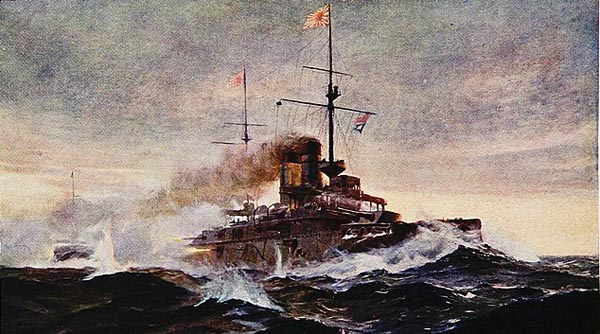
British painting of the battleship as she sail towards Japan in 1898.
The 1896 plan was drawn from combat experience in the First Sino-Japanese War, just a year prior. The Imperial Japanese Navy staff decided to get rid of the Jeune École naval philosophy and to turn towards a more conventional approach with series of modern battleships, and promulgated an ambitious ten-year naval build-up. This expansion was also in preparation for future wars and included six battleships and six armoured cruisers (it was also called ‘plan 6-6’ for this reason). These battleships were also funded by using the £30,000,000 indemnity paid by China as “war reparation”. Before the plan was even enacted, the Japanese already ordered their first two modern pre-dreadnought, the Fuji class. Lacking both the technology and shipbuilding capability the United Kingdom was charged to provide the next four remaining battleships of this programme. After the Shikishima class, the fifth battleship ordered in Britain to Clydebank Engineering & Shipbuilding Company shipyard (Clydebank) as part of 1897 annual naval programme, was largely a revised version of the Shikishima class to gain time and simplify specs.
Design of Asahi
IJN Asahi was very close to the Shikishima, to the point some authors assimilated them in the same class. There is truth in this, same designer, same order, but different yards and some modifications regarding power, dimensions and tonnage, and also armament. The most striking clue was the presence of two funnels instead of three.
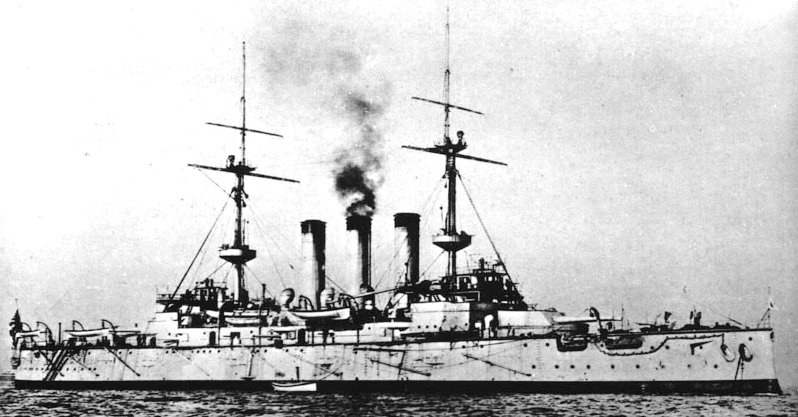
The previous Shikisima class
Basically Asahi’s design was a modified Formidable-class battleship of the Royal Navy, but with two additional 6-inch guns. Asahi overall was 425 feet 3 inches (129.6 m) long for 75 feet (22.9 m) wide, with a normal draught of 27 feet 3 inches (8.3 m). Her displacement was 15,200 long tons (15,400 t) standard. She was shorter, slimmer, but with the same draught but heavier displacement (14,850–15,000 long tons normal for the previous Shikishima. The main reason was the heavier machinery and extra compartimentation of ASW protection (meaning more metal for separations). IJN Asahi was fitted as a flagship with a crew extended to 773, between officers and enlisted me and admiral’s staff.
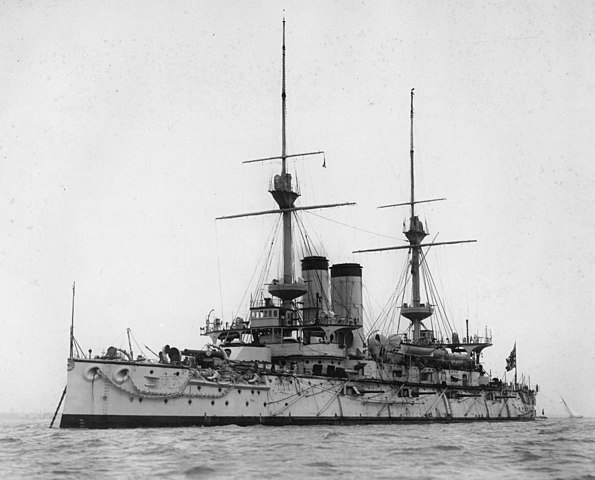
IJN Asahi in 1900.
Propulsion
The ship was given two vertical triple-expansion (VTE) steam engines from Humphrys, Tennant. Each drove a single bronze propeller. Steam came from 25 Belleville boilers, working at 1,703 kPa or 247 psi (17.03 bar). They were were rated at 15,000 indicated horsepower (11,000 kW) on forced draught, allowing a top speed of 18 knots (33 km/h; 21 mph) as requested. After troubles with the boilers were quelled, on trials Asahi reached 18.3 knots (33.9 km/h; 21.1 mph), achieving a total output of 16,335 ihp (12,181 kW). This was recorded on 23 March 1900. Range depending of the 2,000 long tons (2,032 t) of coal carried wherever possible, making it to cover 9,000 nautical miles (17,000 km; 10,000 mi) in one go at 10 knots. For electrical power, Asahi also was supplied by three steam-driven 4.8-kilowatt (6.4 hp) dynamos. Although exhausts were truncated into two funnels, they were unequal. The aft one concentrated more exhaust tubes, and therefore it was not round in section, but ovale, although from profile it had the same appearance. This was done in part for aesthetic reasons. The powerplant was basically the same as in the Shikishima class. The only change was in the compartimentation, more torough n Asahi.
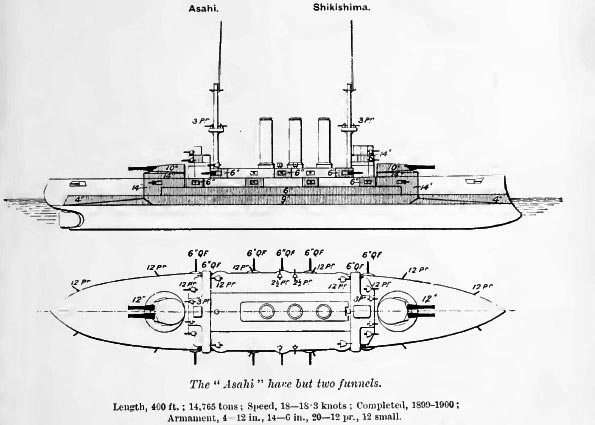
Blueprint
Armour protection
The Main armored belt (Harvey steel) extended over 76.2m over the hull’s broadside, in between barbettes, on 2.5m high. Its thickness amidships reached 229mm down to 127mm on the lower edge, and tapered down, first to 178mm and then down to 102mm ship at the ends. It connected with the main gun barbettes as the “box” was closed by 356 mm (14 in) down to 152 mm (6 in) transverse bulkheads. There was a second, upper armoured belt at casemate level, over 66m lenght, and 152mm or 6-inches thick over 2.3m in height. The Casemates themselves were protected by 152mm (6 in) faces and 51mm (2.1 in) back armor. The main guns barbettes walls were 356 mm (14 in) thick above the main armored deck level, tapered down to 203 mm or 8 inches under it. The main turrets were protected by 254 mm (10 in) faces, while the sides were 203 mm or 8 inches thick, with roofs 102mm thick (4 inches). The forward conning tower (CT) had 356 mm (14 in) walls and was topped by a 76mm (3 in) roof. The citadel connected with the lower edge of the main belt was topped by 2 inches armor (51mm) with 4 inches slopes (102mm, creating a turtleback caying from 76 to 51mm in thickness (3-in to 2-in). For ASW protection, Asahi had a full lenght, complete double bottom, with 55 watertight compartments, subdivided into 223 watertight compartments total. This was way more than the previous Shikishima class, notably in case of mine damage.
- Main Belt: 9in – 5in, 7in – 4in (229-127, 178-102mm)
- Upper Belt: 6in (152 mm)
- Bulkheads: 14in – 6in (356 – 152 mm)
- Armored Decks: 2in – 4in (51 – 102 mm)
- Main Turrets: 10 in/8 in/4 in (254/203/102mm)
- Barbettes: 14 in/8 in (356/203 mm)
- Casemates:6 in/2.1 in (152/51mm)
- Conning Tower:14 in/3 in (356/76mm)
- Citadel:3 in/2 in (76-51mm)
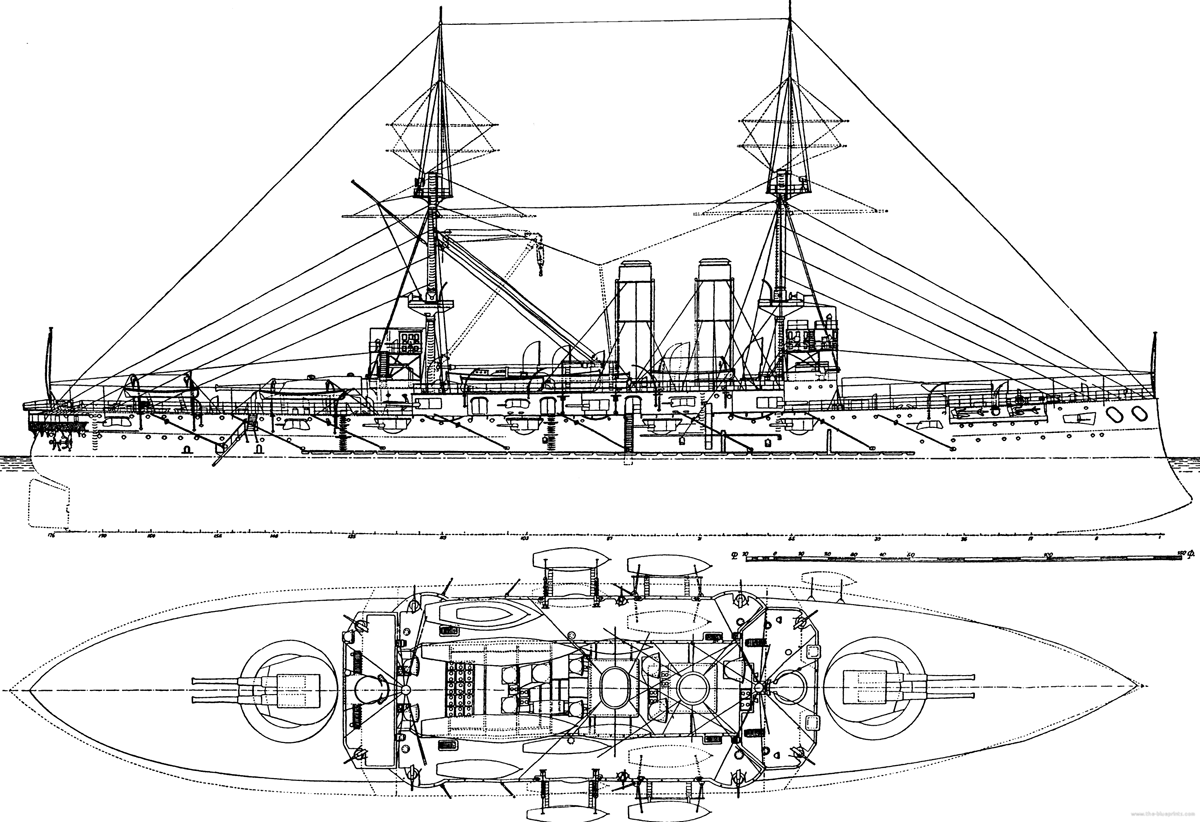
2-view detailed plan theBlueprint.com
Armament
Main battery:
Four Elswick Ordnance twelve-inch guns (305 mm)/40 caliber. These were standard since the Fuji and remains so for a long time. The twin-gun turrets fore and aft were faceted, with a front plate two oblique side plates and a rounded back. mountings and turret bearings were hydraulically powered. The while system allowed to load the guns at all angles of traverse (240°) but fixed elevation of +13.5°. These guns fired a 850-pound (386 kg) HE or AP shell at 2,400 ft/s (730 m/s).
Secondary battery:
Fourteen Vickers Type 41 6-in/40 QF guns, all mounted in casemates. Eight on the main deck, broadside, and the remaining six guns on the casemate roof, in the superstructure. They fired a 100-pound (45 kg) shell at 2,300 ft/s (700 m/s).
light artillery:
To deal with TBs, Asahi was given twenty 12-pounder (76 mm, 3 inches), 12 cwt QF guns, firing a 12.5-pound (5.7 kg) HE projectile at 2,359 ft/s (719 m/s). This was completed by four 3-pdr (47 mm, 1.9 in) and six 2.5-pounder (same caliber, shorter barrels).
Torpedo Armament:
Four submerged 18-inch torpedo tubes paired on each broadside.
FCS:
Asahi was fitted with four British Barr & Stroud FA3 coincidence rangefinders. They were effective up to 8,000 yards (7,300 m). This was completed by a set of 24x magnification telescopic gunsights.
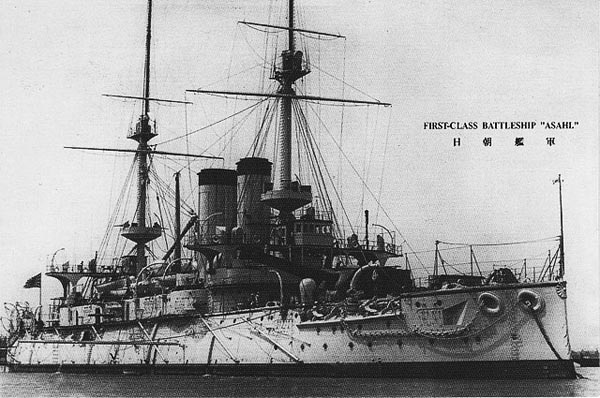
IJN Asahi, book scan of a postcard (cc)
- Main Artillery: 2×2 12-in (305mm)
- Secondary artillery: 14x 6-in (152 mm)
- Light artillery 1: 20x 3-in (76 mm)
- Light artillery 2: 6x 3-pdr + 6x 2.5-pdr (47 mm)
- Torpedo Tubes: 4x 18-in sub. (457mm)
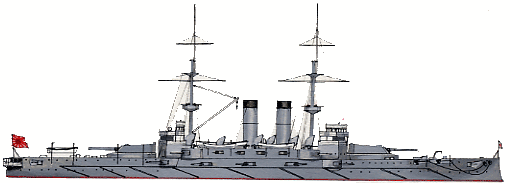
Author’s profile of the IJN Asahi
⚒ Features (as built) |
|
| Displacement: | 15,200 tons standard, 15.374 tons FL |
| Dimensions: | 415/425 x 75 x 27ft (129.6 x 22.92 x 8.3 m) |
| Propulsion: | 2 shafts VTE, 10 cyl. boilers, 15,000 ihp, 18 knots (33 km/h; 21 mph) |
| Armour: | Belt 9 in, decks 4 in, barbettes 14 in, Turrets 6-in, CT 14-in, casemates 2in |
| Armament: | 2×2 12-in, 14× 6-in, 20×12-pdr, 6x 3-pdr, 6x 2-1/2 in, 4× 18-in TTs |
| Crew: | 836 |
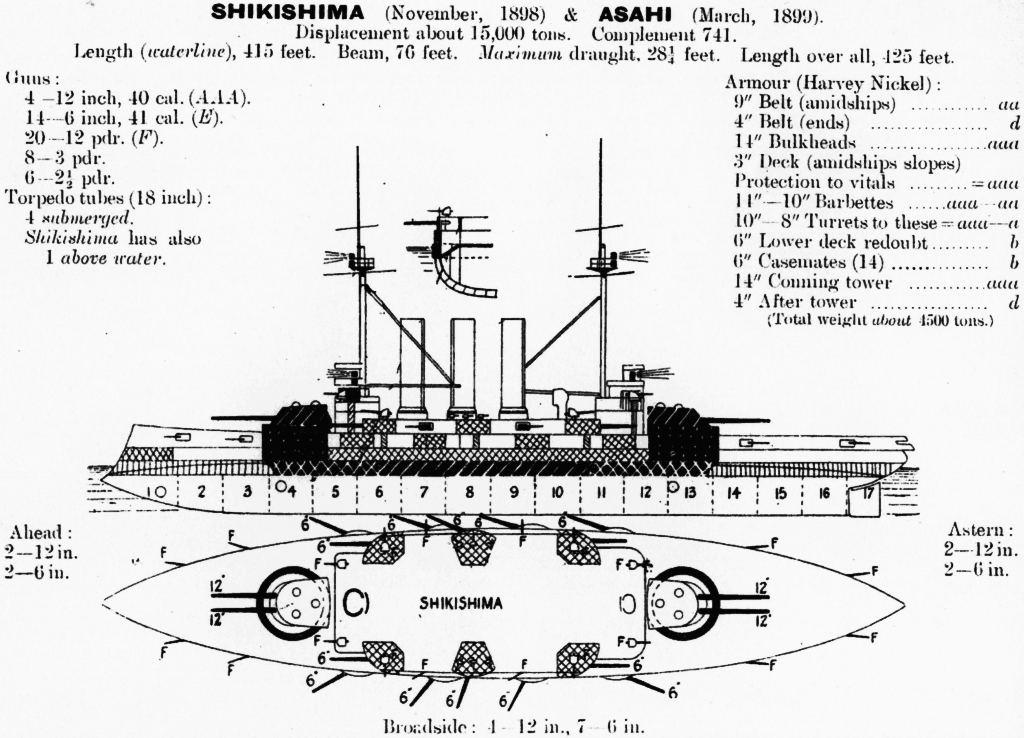
Sources/read more
Conway’s all the world’s battleships 1860-1905
Brook, Peter (1999). Warships for Export: Armstrong Warships 1867–1927. Gravesend, Kent, UK: World Ship Society.
Campbell, N.J.M. (1978). “The Battle of Tsu-Shima”. In Preston, Antony (ed.). Warship II. London: Conway Maritime Press
Evans, David & Peattie, Mark R. (1997). Kaigun: Strategy, Tactics, and Technology in the Imperial Japanese Navy, 1887–1941.
Forczyk, Robert (2009). Russian Battleship vs Japanese Battleship, Yellow Sea 1904–05.
Friedman, Norman (2011). Naval Weapons of World War One. Barnsley, UK: Seaforth
Hackett, Bob & Kingsepp, Sander (2010). “IJN Repair Ship Asahi: Tabular Record of Movement”. Kido Butai. Combinedfleet.com.
Head, Michael (2019). “Siberia”. Warship International. LVI (1) 55–74.
Jentschura, Hansgeorg; Jung, Dieter & Mickel, Peter (1977). Warships of the Imperial Japanese Navy, 1869–1945.
Lengerer, Hans (September 2008). Ahlberg, Lars (ed.). “Japanese Battleships and Battlecruisers – Part II”.
Lengerer, Hans (March 2009). Ahlberg, Lars (ed.). “Japanese Battleships and Battlecruisers – Part III”.
Preston, Antony (1972). Battleships of World War I: An Illustrated Encyclopedia of the Battleships of All Nations 1914–1918.
Silverstone, Paul H. (1984). Directory of the World’s Capital Ships. New York: Hippocrene Books.
Warner, Denis & Warner, Peggy (2002). The Tide at Sunrise: A History of the Russo-Japanese War, 1904–1905 (2nd ed.).
Sites
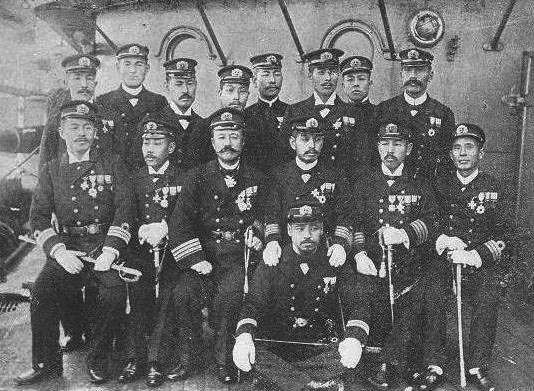
Officers on board prior to the Russo-Japanese war
On navypedia
On combinedfleet.com
//en.wikipedia.org/wiki/Japanese_battleship_Asahi
//commons.wikimedia.org/wiki/Category:Asahi_(ship,_1900)
//www.subsim.com/radioroom/showthread.php?t=117074
//marekj655.blogspot.com/p/auxiliary-ships-tankers-supply-ships.html
Model kit of IJN Asahi
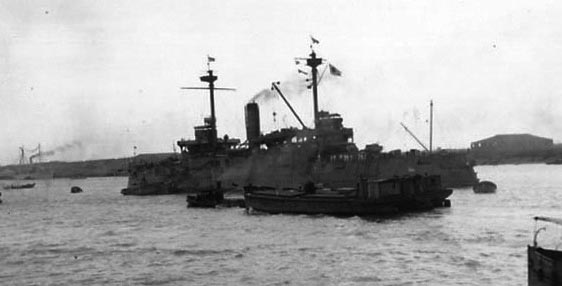
IJN Asahi as depot ship, late 1930s
Foresight | No. MSM004 | 1:500 (Link on scalemates)
The same made by Chris Medding on modelshipgallery.com
Eaglemoss Collections 1:1100 EMGC69
1:1200 METAL MODEL built by JOHN BROWN and CO (1900)
Note: The Asahi seems to not have much inspired modellers. To make it, better to take on of the more numerous avatars of IJN Mikasa and modify it.
Unfortunately i was not able to find a blueprint of the IJN Asahi as depot ship, submarine salvage or repair vessel, or even a clean, detailed photos.
Three wars for a 40 years career
Forty year is a lot for a warship, mostly due to technology, making any virtually obsolete in less than a decade. In the civilian service, a ship could be overhauled and rebuilt anew, as its core principle (carying passengers and cargo) is simple enough. There are many example of ships managing to change owners ten times over an almost 100-years long career. But a warship was geared for war by design, in a context which was way more darwinian an din which nature is replaced by a fierce technological competition to both hitting hard and resisting just as much, in the case of a battleship, reigning supreme on the “food chain” of naval warfare. Changes in gunnery (barrels and mountings), loading chain, speed of all mechanical components, power supply, targeting accuracy and calculation, armour composition and endless variations of internal management linked to statistic data, ballistic science and shell technology, all these parameters are constantly evolving, and the book is revised each time a conflict puts theory to the ultimate life-and-death test.
So in that context, we can assume a ship is obsolete after 20 years a the most, if not modernized more of less thoroughly. Such was not the case for Asahi, which stayed pretty much “in her juice” during both the Russo-Japanese war of 1905 and WWI as well as the early interwar, at least until 1926 and her conversion to a salvage vessel and later repair ship, stripped down of armour and armament. In that case, her active life, as a battleship, went on for 26 years, which was already quite long conidering her design went back to 1896. Her second life brought her about 15 more years in hr new roles, which changed, with reserve period in between. All settled, it’s not as a battleship she was sunk, but she surely flew the Hinomaru, with a qualified Imperial Japanese Navy crew.
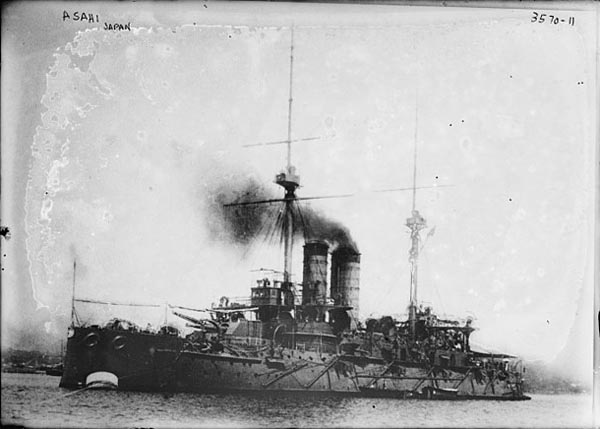
IJN Asahi – Library of Congress
Asahi “rising sun” a waka poetry metaphor of Japan, was laid down on 1 August 1898 in Clydebank yard (Scotland) but completed by John Brown co. (same yard, same place, but the latter purchased the firm in between. IJN Asahi was launched on 13 March 1899, completed on 31 July 1900, delayed for three months when her bottom plating required repairs. Indeed during her initial sea trials she ran aground off Southsea. She was commissioned and departed Portsmouth where she was repaired, making it to Yokosuka on 23 October 1900. There, she immediately became flagship of the Standing Fleet, on 22 May 1901, and head of the 1st Battleship Division, 1st Fleet when the Combined Fleet was created on 28 December 1903. She was the IJN’s spearhead. Nothing much happened prior to the Russo-Japanese war, she spent her time in home waters training, practicing gunnery.
The Russo-Japanese war (1904-1905)
IJN Asahi (Captain Hikohachi Yamada) was assigned to the 1st Division, 1st Fleet and was present during the attack of Port Arthur on 9 February 1904. Vice Admiral Tōgō launched TBs inside the port and crippled the Pacific Squadron anchored outside Port Arthur. The surprise night attack was in fact less successful than expected and despite the Russians were disorganized and weakened, they put up a fight during the following battle. Boyarin spotted the IJN fleet first when patrolling offshore raising, the alert. Tōgō started to deal with coastal defences, punding them with the HE shells stocks onboard his battleships, while he decided to engage lighter ships with his secondary artillery. This splitting proved to be a poor decision as the largely unharmed Russians quickly opened fire and had many hits. Tōgō disengaged and Asahi was not hit during the battle.
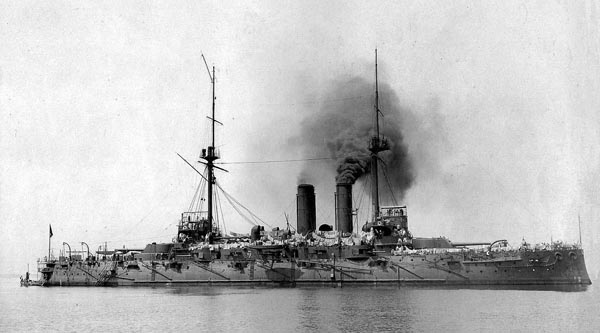
She also took part in the 13 April action, trying to lure out a portion of the Pacific Squadron. Petropavlovsk indeed sortied but Makarov turned back when spotting the Japanese, and famously struck a recently laid Japanese minefield, sinking raidly after a magazine detonation. Tōgō used Asahi and his other battleship to continue pounding Russian defenses, while the latted laid more minefields, later claiming two Japanese battleships in May. Asahi also took part in the Battle of the Yellow Sea on 10 August 1904, this time under command of Captain Tsunaakira Nomoto. During the battle she was second in line behind Mikasa, and was targeted by Russian ships, but luckly enough to take just one 12 inches hit, wounding two. Her aft 12-in gun turret was however later disabled by accidental shell explosions. Asahi, with her remaining forward turret, concentrated on Poltava and Tsesarevich, both being lightly damaged. However later she hit the bridge of Tsesarevich, killing the Russian squadron commander (Vice Admiral Wilgelm Vitgeft), creating mass confusion until Rear Admiral Prince Pavel Ukhtomsky regained control of the squadron, heading back to Port Arthur. On 26 October, it was Asahi’s turn to run out of luck when she struck a mine off Port Arthur during her blockade run. She survived by was barely able to get back in home waters under her own power. There, she was repaired at Sasebo Naval Arsenal, from November 1904 to April 1905. This was soon enough to take part in the final match: Tsushima.
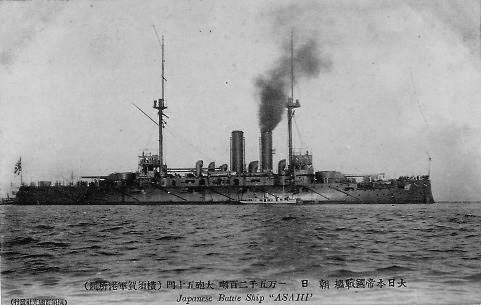
Asahi in 1905
The Battle of Tsushima on 27 May 1905 saw IJN Asahi behind Mikasa again in the battleline, pitted against the combined might of the newly created Second and Third Pacific Squadrons. Mikasa concentrated first on Knyaz Suvorov, the Russian flagship, together with Asahi and Azuma. Vice Admiral Zinovy Rozhestvensky was badly wounded and his ship was put ablaze. Indeed, rather than pounding their belt with AP shells, Togo gave instruction to fire HE shells on their superstrctures instead, and this paid off. Knyaz Suvorov lost her aft 12-in turret and her steering as well. She fell out of formation but the Russian still kept ordered and concentrated on Mikasa, Asahi being spared. Tōgō eventually crossed the T of the Russian squadrons. Asahi concentrated on the battleships Borodino and Oryol later during the battle, and Fuji eventually made the lucky shot that ignited Borodino’s magazines. Asahi fired in fact 142 main shells, the most of any other battleship that day.
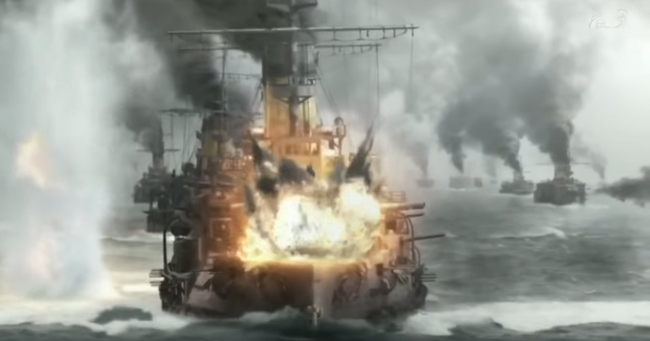
She was hit six times in return, but with moderate to light damage, lossing one officer and six, 24 wounded. During the battle, there was one wastern officer onboard Asahi: Captain W. C. Pakenham, the only RN official military observer (as per the Anglo-Japanese Alliance conditions), which took notes of the battle from her exposed quarterdeck. His report was crucial in reaffirming confidence in British training methods, as applied by the Japanese, and their tactics. The Japanese in a sense, were a proxy of Great Britain against Russia, as both empires were at odds since the late 1890s. This almost went to a quasi-war as the Baltic squadron departed and fired on British trawlers, thought to be IJN TBs.
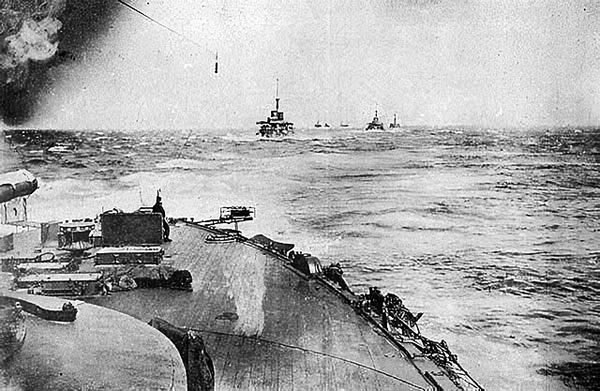
The IJN fleet in 1905 in 1905
The great war (1905-1922)
Asahi’s crew and captain were awarded and congratulated back home during victory paradesin 1905-1906, but less than the Mikasa, arguably much more battered by the Russians, and crucially, Togo’s flagship, the new national hero of Japan. Soon, the routine of exercises and training went back to normal, in 1906, 1907 and 1908, albeit the Japanese admiralty was now aware of the new trends in battleship design, the dreadnought, and Asahi like other pre-dreadnoughts was retrograded in the 3rd battle squadron, 1st fleet. In 1908, she took part in a honorary IJN squadron escorting the “Great White Fleet” as it passed through Japanese waters during its round-trip. Assigned to the 1st Fleet again in 1910–11 she became a gunnery training ship in 1914.

The IJN fleet in 1905
She stayed in home waters during IJn attacks on German poessessions in the pacific and the siege of Tsingtao. In 1917 Asahi was re-armed with newly cast Japanese guns. She was assigned to the 5th Division, 3rd Fleet and in 1918, became flagship of it. She participated in the Russian Civil War Japanese expedition, escorting troop convoys to the Far East. She was also used a guard ship in Kamchatka, from January to August 1918. Reclassified as a first-class coastal defence ship on 1 September 1921 Asahi was scheduled for reserve. In 1922 at Yokosuka, as a result with the terms of the Washington Naval Treaty she was taken in hands to be disarmed. A new era started.
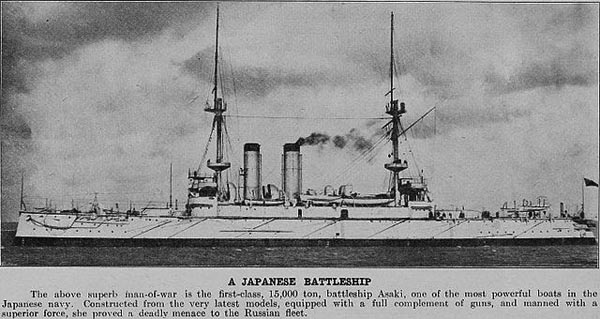
Early Interwar years (1922-1926)
Asahi after the removal of her armour, main and secondary guns, was reclassified as a training vessel, as well as a submarine depot ship, on 1 April 1923, her final fittings complete in July. Due to the removal of her artillery and armour, she displaced now 11,441 long tons, but also accoridng to the treaty her machinery was stripped down and halved, so she was down, despite this loss of weight, to 12 knots (22 km/h; 14 mph) top speed. But the navy wanted later to go further in her depot ship role and wanted Asahi to be converted also as a submarine salvage ship. She was taken in hands in February-August 1925. This early conversion saw the fitting of specialized salvage equipment. From 1926 to October 1927 she was back in drydoc, this time to have her entire machinery removed, her decks gutted to access them. In place of her old Belleville boilers, she received four modern oil-fired Kanpon Type RO boilers, at Kure Naval Arsenal. This new machinery resulted in less exhaust tubes and one funnel was removed. To perform her task, she was given a large structure supporting two lifting frames and winches. This apparatus allowed her to effectively lift a submerged, damaged submersible or repair it.
As these techniques were relatively new at that time, she conducted experiments first, performing eventually a frst rescue of the submarine old 0-1 (ex-U-125), a former German war prize. On May 1928, she also received a 62-foot-4-inch (19 m) compressed-air aircraft catapult, fitted on her forecastle. It was a testbed for catapult, rather than having any practical use in her role, but to possibly locate submerged damaged submersibles. She launched an E2N1 Type 15 seaplane for the first time but accidents were frequent, to the point it was decided eventually to remove the catapult, and replace it by a new model using gunpowder. Her testings took place all along the year 1928, and when completed, Asahi was placed in reserve.
Asahi WW2
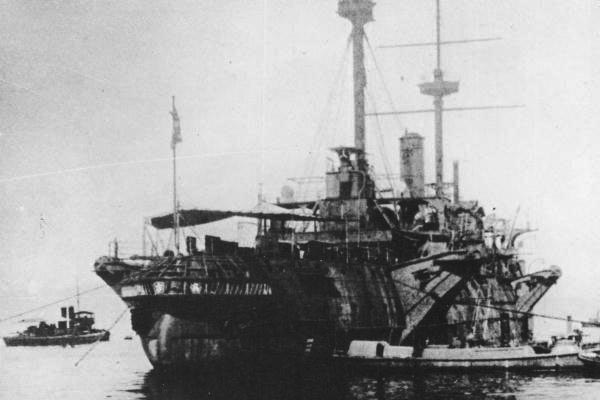
Prior to WW2, Asahi experienced another conversion after years in reserve: Reclassified as a repair ship on 16 August 1937 she was taken out of reserve in November. The Marco Polo Bridge Incident indeed quickstarted the Second Sino-Japanese War. It was judged more useful to use her as as a transport ship, helping landing troops at Hangzhou Bay. After the coast was secured, she was back home for a new conversion, performed at Kure, as a fully-fledged universal repair ship. This conversion work, keeping parer of the former equipment but adding some, was completed on 18 December 1938. Asahi (amazingly she did not changed name by that time), was fitted with a dummy wooden main battery fore and aft, as a deterrence to any Chinese attack. She sailed to Shanghai on 29 December for her deployment. She soldiered on in 1938 betwee the coast and Japanese waters. By May 1939, she was modified again. This third conversion saw her used as a torpedo depot ship. But she still operated along the coast, patrolling between 29 May and 7 November 1940. She eventually ended before Pearl Harbor at Camranh Bay in French Indochina, on 15 November 1940. There, she was used to carry he 11th Base Unit from Kure, landed at Camranh Bay on 19 November and the ship brought them support until the base was finalized on 7 December 1941.
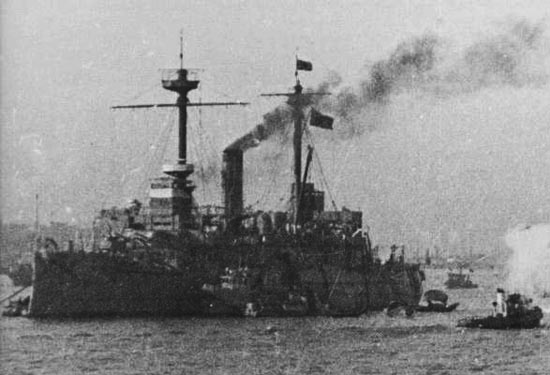
IJN Asahi a submarine tender and repair ship in Shanghai, 1938
on 13 March 1942, Asahi was anchored in Singapore, which fell in February. In April she was noted in her new role for quickly repairing the light cruiser Naka previously torpedoed by the USS Seawolf off Christmas Island and almost destroyed. Asahi also performed repairs of many other ships but by May she needed maintenance and parts, and her captain prepared her departure for home waters. She left Singapore for Kure on 22 May 1942, escorted by the subchaser CH-9. While she was underway approximatively 100 miles (160 km) southeast of Cape Padaran (Indochina), IJN Asahi was spotted by the submarine USS Salmon by night between the 25 and 26 May 1942. Placed already in ambush, USS salmon manoeuvered to be in an ideal position, firing her four bow torpedoes. Two hit the old battleship in her port central boiler room. The aft compatments were hit as well. Thanks to her ASW compartimentation, she took time to list nd sank, which she did at 01:03, approx. 10°00′N 110°00′E, and carrying with her to the bottom 16 men, some killed alreay in the impact. However her captain and 582 crewmen survived, quickly rescued by CH-9.



 Latest Facebook Entry -
Latest Facebook Entry -  X(Tweeter) Naval Encyclopedia's deck archive
X(Tweeter) Naval Encyclopedia's deck archive Instagram (@navalencyc)
Instagram (@navalencyc)





 French Navy
French Navy Royal Navy
Royal Navy Russian Navy
Russian Navy Armada Espanola
Armada Espanola Austrian Navy
Austrian Navy K.u.K. Kriegsmarine
K.u.K. Kriegsmarine Dansk Marine
Dansk Marine Nautiko Hellenon
Nautiko Hellenon Koninklije Marine 1870
Koninklije Marine 1870 Marinha do Brasil
Marinha do Brasil Osmanlı Donanması
Osmanlı Donanması Marina Do Peru
Marina Do Peru Marinha do Portugal
Marinha do Portugal Regia Marina 1870
Regia Marina 1870 Nihhon Kaigun 1870
Nihhon Kaigun 1870 Preußische Marine 1870
Preußische Marine 1870 Russkiy Flot 1870
Russkiy Flot 1870 Svenska marinen
Svenska marinen Søværnet
Søværnet Union Navy
Union Navy Confederate Navy
Confederate Navy Armada de Argentina
Armada de Argentina Imperial Chinese Navy
Imperial Chinese Navy Marinha do Portugal
Marinha do Portugal Mexico
Mexico Kaiserliche Marine
Kaiserliche Marine 1898 US Navy
1898 US Navy Sovietskiy Flot
Sovietskiy Flot Royal Canadian Navy
Royal Canadian Navy Royal Australian Navy
Royal Australian Navy RNZN Fleet
RNZN Fleet Chinese Navy 1937
Chinese Navy 1937 Kriegsmarine
Kriegsmarine Chilean Navy
Chilean Navy Danish Navy
Danish Navy Finnish Navy
Finnish Navy Hellenic Navy
Hellenic Navy Polish Navy
Polish Navy Romanian Navy
Romanian Navy Turkish Navy
Turkish Navy Royal Yugoslav Navy
Royal Yugoslav Navy Royal Thai Navy
Royal Thai Navy Minor Navies
Minor Navies Albania
Albania Austria
Austria Belgium
Belgium Columbia
Columbia Costa Rica
Costa Rica Cuba
Cuba Czechoslovakia
Czechoslovakia Dominican Republic
Dominican Republic Haiti
Haiti Hungary
Hungary Honduras
Honduras Estonia
Estonia Iceland
Iceland Eire
Eire Equador
Equador Iran
Iran Iraq
Iraq Latvia
Latvia Liberia
Liberia Lithuania
Lithuania Mandchukuo
Mandchukuo Morocco
Morocco Nicaragua
Nicaragua Persia
Persia San Salvador
San Salvador Sarawak
Sarawak Uruguay
Uruguay Venezuela
Venezuela Zanzibar
Zanzibar Warsaw Pact Navies
Warsaw Pact Navies Bulgaria
Bulgaria Hungary
Hungary

 Bundesmarine
Bundesmarine Dutch Navy
Dutch Navy Hellenic Navy
Hellenic Navy Marina Militare
Marina Militare Yugoslav Navy
Yugoslav Navy Chinese Navy
Chinese Navy Indian Navy
Indian Navy Indonesian Navy
Indonesian Navy JMSDF
JMSDF North Korean Navy
North Korean Navy Pakistani Navy
Pakistani Navy Philippines Navy
Philippines Navy ROKN
ROKN Rep. of Singapore Navy
Rep. of Singapore Navy Taiwanese Navy
Taiwanese Navy IDF Navy
IDF Navy Saudi Navy
Saudi Navy Royal New Zealand Navy
Royal New Zealand Navy Egyptian Navy
Egyptian Navy South African Navy
South African Navy






























 Ukrainian Navy
Ukrainian Navy dbodesign
dbodesign